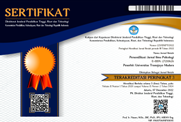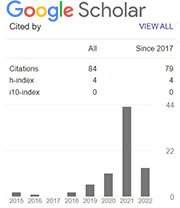Kaitan Moral Disengagement dan Aggressive Driving Behavior : Tinjauan Pada Remaja Pengendara Sepeda motor
Abstract
One of the factors of high traffic accidents is the growing rate of vehicles. In Indonesia, traffic accidents that occur are dominated by two-wheeled vehicles, namely motorcycles and often involve young drivers. One of the causes of adolescent involvement in accidents is aggressive driving behavior which can be influenced by moral disengagement. This quantitative study aims to determine the role of moral disengagement on aggressive driving behavior in adolescent motorcyclists. The hypothesis of this research is that moral disengagement plays a role to aggressive driving behavior on adolescent motorcyclist. This research uses purposive sampling as a sampling technique. The respondents range from 14-19 year old motorcyclists in Palembang, amounting to about 150 respondents. The instrument used is the Aggressive Driving Behavior Scale (ADBS) by Houston et al. (2003) and the Moral Disengagement Scale by Bandura et al. (1996), both modified. Simple regression technique was used to analyze the research data and with the help of IBM SPSS 22. Based on the results of the regression analysis, the R square value between moral disengagement and aggressive driving behavior is 0.107, the F value is 17.682, and the significance value is 0.000 (p smaller than 0.005). This shows that moral disengagement has a significant role in aggressive driving behavior. Thus, the hypothesis proposed by this study can be accepted.
Keywords
Full Text:
PDF (Bahasa Indonesia)References
Allemand, M., Job, V., & Mcroczek, D. K. (2019). Self-control development in adolescence predicts love and work in adulthood. J Pers Soc Psychol, 117(3), 621–634. https://doi.org/10.1037/pspp0000229.Self-Control
Angeline, P., & Arjadi, R. (2021). Peran kontrol diri sebagai prediktor perilaku mengemudi agresif pada pengemudi mobil di jakarta. Manasa, 10(1), 55–64. https://doi.org/10.25170/manasa.v10i1.2415
Bandura, A. (1999). Personality and social psychology review moral disengagement in the perpetration of inhumanities. Personality and Social Psychology Review, 3(3), 179–192. https://doi.org/10.1207/s15327957pspr0303
Bandura, A. (2016). Moral disengagement: How people do harm and live with themselves. Worth Publishers.
Bandura, A., Barbanelli, C., Caprara, G. V., & Pastorelli, C. (1996). Selective moral disengagement in the exercise of moral agency. Journal of Moral Education, 71(2). https://doi.org/10.1080/0305724022014322
Bjärehed, M., Thornberg, R., Linda Wänström, & Gini, G. (2020). Mechanisms of moral disengagement and their associations with indirect bullying , direct bullying , and pro-aggressive bystander behavior. Journal of Early Adolescence. https://doi.org/10.1177/0272431618824745
Chomeya, R. (2010). Aggressive driving behavior: undergraduate students study. Journal of Social Sciences, 6(3), 411–415. https://doi.org/10.3844/jssp.2010.411.415
Cnnindonesia.com. (2021). 100 ribu kecelakaan lalin pada 2020, pelajar sma terbanyak. Di akses dari https://www.cnnindonesia.com/teknologi/20210310124314-384-615978/100-ribu-kecelakaan-lalin-pada-2020-pelajar-sma-terbanyak pada tanggal 25 Februari 2022.
Constantinou, E., Panayiotou, G., Konstantinou, N., Loutsiou-Ladd, A., & Kapardis, A. (2011). Risky and aggressive driving in young adults: Personality matters. Accident Analysis and Prevention, 43(4), 1323–1331. https://doi.org/10.1016/j.aap.2011.02.002
Dahlen, E. R., Edwards, B. D., Tubré, T., Zyphur, M. J., & Warren, C. R. (2012). Taking a look behind the wheel: an investigation into the personality predictors of aggressive driving. Accident Analysis and Prevention, 45, 1–9. https://doi.org/10.1016/j.aap.2011.11.012
Deser, J. R., Treviño, L. K., & Sweitzer, V. L. (2008). Moral disengagement in ethical decision making: a study of antecedents and outcomes. Journal of Applied Psychology, 93(2), 374–391. https://doi.org/10.1037/0021-9010.93.2.374
Ellwanger, S. J., & Pratt, T. C. (2014). Self-control, negative affect, and young driver aggression: an assessment of competing theoretical claims. International Journal of Offender Therapy and Comparative Criminology, 58(1), 85–106. https://doi.org/10.1177/0306624X12462830
Enggarsasi, U., & Sa’diyah, N. K. (2017). Kajian terhadap faktor-faktor penyebab kecelakaan lalu lintas dalam upaya perbaikan pencegahan kecelakaan lalu lintas. Perspektif, 22(3), 228. https://doi.org/10.30742/perspektif.v22i3.632
Gini, G., Pozzoli, T., & Bussey, K. (2015). The role of individual and collective moral disengagement in peer aggression and bystanding: a multilevel analysis. Journal of Abnormal Child Psychology, 43(3), 441–452. https://doi.org/10.1007/s10802-014-9920-7
Gutzwiller-helfenfinger, E. (2016). Moral disengagement and aggression: comments on the special issue. Merrill-Palmer Quarterly, 61(1), 192–211.
Harris, P. B., & Houston, J. M. (2010). Recklessness in context: individual and situational correlates to aggressive driving. Environment and Behavior, 42(1), 44–60. https://doi.org/10.1177/0013916508325234
Hertz, S. G., & Krettenauer, T. (2016). Does moral identity effectively predict moral behavior?: a meta-analysis. Review of General Psychology, 20(2), 129–140.
Houston, J. M., Harris, P. B., & Norman, M. (2003). The aggressive driving behavior scale: Developing a self-report measure of unsafe driving practices. North American Journal of Psychology, 5(2), 269–279.
Jovanović, D., Lipovac, K., Stanojević, P., & Stanojević, D. (2011). The effects of personality traits on driving-related anger and aggressive behaviour in traffic among serbian drivers. Transportation Research Part F: Traffic Psychology and Behaviour, 14(1), 43–53. https://doi.org/10.1016/j.trf.2010.09.005
Kurniasih, D., Rosydah, B. M., & Sandora, R. (2017). The effect of big five personality on aggressive driving behavior among angkot drivers in surabaya. Dama International Journal of Researchers, 2(10).
Lo Cricchio, M. G., García-Poole, C., te Brinke, L. W., Bianchi, D., & Menesini, E. (2020). Moral disengagement and cyberbullying involvement: a systematic review. European Journal of Developmental Psychology, 1–41. https://doi.org/10.1080/17405629.2020.1782186
Luthfie, A. (2014). Pengaruh self-control dan moral disengagement terhadap aggressive driving pada pengemudi sepeda motor. Skripsi (tidak dipublikasikan). Jakarta : UIN Syarif Hidayatullah.
Moore, C. (2015). Moral disengagement. Current Opinion in Psychology, 6(August 2015), 199–204. https://doi.org/10.1016/j.copsyc.2015.07.018
Moore, C., Detert, J. R., Klebe Treviño, L., Baker, V. L., & Mayer, D. M. (2012). Why employees do bad things: moral disengagement and unethical organizational behavior. Personnel Psychology, 65(1), 1–48. https://doi.org/10.1111/j.1744-6570.2011.01237.x
Otosia.com. (2021). Anak muda banyak terlibat kecelakaan karena tidak berpikir panjang. Diakses dari https://www.otosia.com/berita/anak-muda-banyak-terlibat-kecelakaan-karena-tidak-berfikir-panjang.html pada tanggal 25 Februari 2022.
Paleti, R., Eluru, N., & Bhat, C. R. (2010). Examining the influence of aggressive driving behavior on driver injury severity in traffic crashes. Accident Analysis and Prevention, 42(6), 1839–1854. https://doi.org/10.1016/j.aap.2010.05.005
Panggabean, W., Hastuti, D., & Herawati, T. (2022). Pengaruh gaya pengasuhan orang tua, identitas moral, dan pemisahan moral remaja terhadap perilaku cyberbullying remaja. Jurnal Ilmu Keluarga Dan Konsumen, 15(1), 63–75.
Rianti, D. F., & Rahardjo, P. (2014). Kontrol diri pada peserta didik di smp negeri 2 kutasari purbalingga tahun pelajaran 2012/2013. Psycho Idea, 1.
Safety, A. F. for T. (2020). 2019 Traffic Safety Culture Index. Washington DC : AAA Foundation
Selatan, B. P. S. S. (2021). Jumlah kendaraan bermotor menurut jenis kendaraan 2018-2020. Diakses dari https://sumsel.bps.go.id/indicator/17/539/1/jumlah-kendaraan-bermotor-menurut-jenis-kendaraan.html pada tanggal 25 Februari 2022.
Soffania, M. I. (2019). Hubungan agressive driving behavior pengemudi sepeda motor dengan kecelakaan lalu lintas. The Indonesian Journal of Public Health, 13(2), 222. https://doi.org/10.20473/ijph.v13i2.2018.222-233
Statistik, B. P. (2021). Perkembangan jumlah kendaraan bermotor menurut jenis (unit), 2017-2019. Diakses dari https://www.bps.go.id/indicator/17/57/1/perkembangan-jumlah-kendaraan-bermotor-menurut-jenis.html pada tanggal 26 Februari 2022.
Stey, P. C., Lapsley, D., & Mckeever, M. O. (2013). European Journal of Moral judgement in adolescents: age differences in applying and justifying three principles of harm. European Journal of Developmental Psychology, 10(2). https://doi.org/10.1080/17405629.2013.765798
Sugiyono, P. D. (2019). Metode Penelitian Kuantitatif, Kualitatif, dan R&D (2nd ed.). Bandung : Penerbit Alfabeta.
Swann, A., Lennon, A., & Cleary, J. (2017). Development and preliminary validation of a scale of driving moral disengagement as a tool in the exploration of driving aggression. Transportation Research Part F: Traffic Psychology and Behaviour, 46, 124–136. https://doi.org/10.1016/j.trf.2017.01.011
Tribunnews.com. (2020). Angka kecelakaan di sumsel naik drastis selama operasi ketupat musi 2020, ini penyebabnya. Diakses dari https://palembang.tribunnews.com/2020/06/16/angka-kecelakaan-di-sumsel-naik-drastis-selama-operasi-ketupat-musi-2020-ini-penyebabnya pada tanggal 26 Februari 2022.
Vazquez, J. (2013). Personality factors, age, and aggressive driving: a validation using a driving simulator. In Electronic Theses and Dissertations. https://doi.org/10.1093/geront/gnv512.09
Velazquez, E. M., & Mouloua, M. (2021). Understanding aggressive driving: the role of personality and individual differences. Proceedings of the Human Factors and Ergonomics Society Annual Meeting, 65(1), 972–976. https://doi.org/10.1177/1071181321651345
Wang, X., Lei, L., Liu, D., & Hu, H. (2016). Moderating effects of moral reasoning and gender on the relation between moral disengagement and cyberbullying in adolescents. Personality and Individual Differences, 98, 244–249. https://doi.org/10.1016/j.paid.2016.04.056
Widhiarso, W. (2010). Uji linieritas hubungan. Manuskrip (Tidak dipublikasikan). Yogyakarta : Universitas Gadjah Mada. Diakses dari http://www.widhiarso.staff.ugm.ac.id/files/widhiarso_2010_uji_linieritas_hubungan.pdf pada tanggal 5 Mei 2022.
DOI: https://doi.org/10.21107/personifikasi.v13i2.17375
Refbacks
- There are currently no refbacks.
Copyright (c) 2022 Amalia Juniarly, Efira Aflah Effendi

This work is licensed under a Creative Commons Attribution 4.0 International License.


Personifikasi by Universitas Trunojoyo Madura is licensed under a Creative Commons Attribution 4.0 International License.










